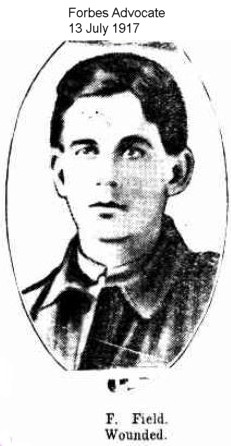Pte
Frederick Field
Informations sur naissance
|
Date de naissance: 24/04/1896 |
|
Lieu de naissance: Forbes, New South Wales, Australia |
Informations générales
|
Profession: Boulanger |
Informations service militaire
|
Pays: Australia |
|
Force armée: Australian Imperial Force |
|
Rang: Private |
|
Numéro de service: 4489 |
|
Incorporation date: 02/09/1915 |
|
Incorporation nom de lieu: Lithgow, New South Wales, Australia |
|
Unités: — Australian Infantry, 2nd Bn. (Dernière unité connue) |
Informations sur décès
|
Date de décès: 27/10/1917 |
|
Lieu de décès: Lijssenthoek, Remy Siding, No. 2 Canadian Casualty Clearing Station, Belgique |
|
Cause du décès: Died of wounds (D.O.W.) |
|
Âge: 21 |
Cimetière
|
Lijssenthoek Military Cemetery Parcelle: XXII Rangée: F Tombe: 20 |
Distinctions et médailles 2
|
British War Medal Médaille |
|
Victory Medal Médaille |
Points d'intérêt 3
| #1 | Lieu de naissance | ||
| #2 | Lieu d'enrôlement | ||
| #3 | Lieu du décès (approximatif) |
Mon histoire
Frederick Field was born in 1896 in Forbes, New South Wales. He was the son of Esther and David Field. According to his service record, he worked as a baker prior to enlisting. In September 1915, when he was 19-years old, Frederick volunteered for the Australian Imperial Force in Lithgow, New South Wales. By the time of the Battle of Passchendaele, he was serving with the 2nd Battalion Australian Infantry, part of the 1st Brigade, of the 1st Australian Division.
On 7 October 1917 Frederick’s Battalion was relieved from the frontlines and moved back to the hinterland. After some well-deserved rest the 2nd Battalion was stationed at a camp near a place called Belgian Battery Corner, close to Belgian Château. Here they waited on orders to go back to the frontline. The Companies started working on improving the camp and working parties were sent to the forward areas. On the 27th of October a German aeroplane, flying very low in the cover of the mist, dropped three bombs on the camp at Belgian Battery Corner. One bomb fell right on the line of tents of “C” Company and inflicted heavy casualties. Twelve men were killed outright, forty-three men were wounded and four men died of their wounds.
Frederick Field was badly wounded in the explosion. According to a Red Cross witness report, a fragment of the bomb had penetrated his back and then his lung. The twenty-one year old was evacuated and admitted to No. 2 Canadian Casualty Clearing Station at Lijssenthoek, where he succumbed to his injuries. On the following day Frederick was buried on the nearby Lijssenthoek Military Cemetery.
On 7 October 1917 Frederick’s Battalion was relieved from the frontlines and moved back to the hinterland. After some well-deserved rest the 2nd Battalion was stationed at a camp near a place called Belgian Battery Corner, close to Belgian Château. Here they waited on orders to go back to the frontline. The Companies started working on improving the camp and working parties were sent to the forward areas. On the 27th of October a German aeroplane, flying very low in the cover of the mist, dropped three bombs on the camp at Belgian Battery Corner. One bomb fell right on the line of tents of “C” Company and inflicted heavy casualties. Twelve men were killed outright, forty-three men were wounded and four men died of their wounds.
Frederick Field was badly wounded in the explosion. According to a Red Cross witness report, a fragment of the bomb had penetrated his back and then his lung. The twenty-one year old was evacuated and admitted to No. 2 Canadian Casualty Clearing Station at Lijssenthoek, where he succumbed to his injuries. On the following day Frederick was buried on the nearby Lijssenthoek Military Cemetery.
Sources 6
|
AIF-Project https://aif.adfa.edu.au Sources utilisées |
|
Australian War Memorial https://www.awm.gov.au/collection/P10860630 Sources utilisées |
|
CWGC https://www.cwgc.org/find-war-dead/casualty/431139/field,-frederick/ Sources utilisées |
|
Service Record http://recordsearch.naa.gov.au/SearchNRetrieve/Interface/SearchScreens/BasicSearch.aspx Sources utilisées |
|
The Long, Long Trail https://www.longlongtrail.co.uk/ Sources utilisées |
|
War Diary A.I.F. 2nd Bn. https://www.awm.gov.au/collection/C1338583 Sources utilisées |
